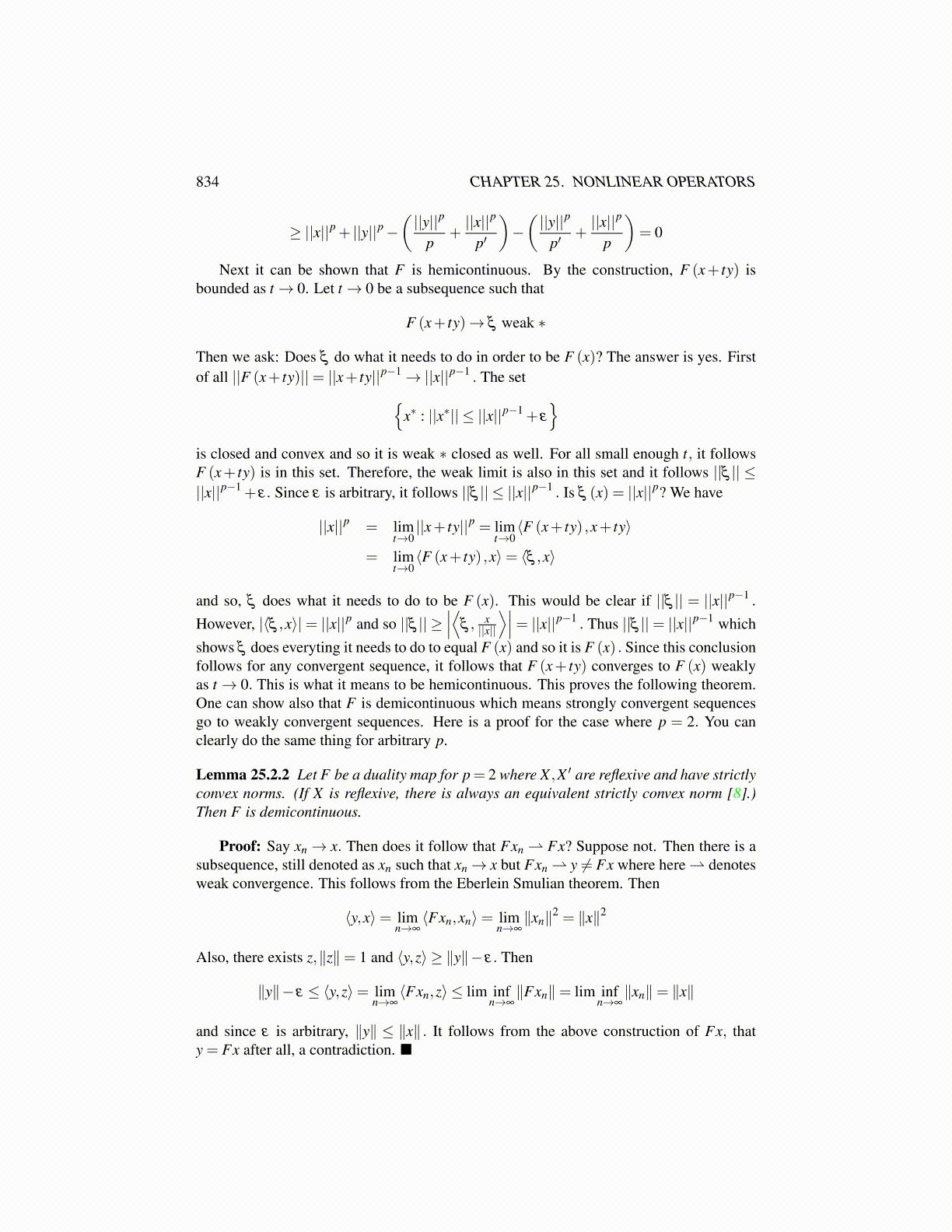
834 CHAPTER 25. NONLINEAR OPERATORS
≥ ||x||p + ||y||p−(||y||p
p+||x||p
p′
)−(||y||p
p′+||x||p
p
)= 0
Next it can be shown that F is hemicontinuous. By the construction, F (x+ ty) isbounded as t→ 0. Let t→ 0 be a subsequence such that
F (x+ ty)→ ξ weak ∗
Then we ask: Does ξ do what it needs to do in order to be F (x)? The answer is yes. Firstof all ||F (x+ ty)||= ||x+ ty||p−1→ ||x||p−1 . The set{
x∗ : ||x∗|| ≤ ||x||p−1 + ε
}is closed and convex and so it is weak ∗ closed as well. For all small enough t, it followsF (x+ ty) is in this set. Therefore, the weak limit is also in this set and it follows ||ξ || ≤||x||p−1 + ε. Since ε is arbitrary, it follows ||ξ || ≤ ||x||p−1 . Is ξ (x) = ||x||p? We have
||x||p = limt→0||x+ ty||p = lim
t→0⟨F (x+ ty) ,x+ ty⟩
= limt→0⟨F (x+ ty) ,x⟩= ⟨ξ ,x⟩
and so, ξ does what it needs to do to be F (x). This would be clear if ||ξ || = ||x||p−1 .
However, |⟨ξ ,x⟩|= ||x||p and so ||ξ || ≥∣∣∣⟨ξ , x
||x||
⟩∣∣∣= ||x||p−1 . Thus ||ξ ||= ||x||p−1 which
shows ξ does everyting it needs to do to equal F (x) and so it is F (x) . Since this conclusionfollows for any convergent sequence, it follows that F (x+ ty) converges to F (x) weaklyas t → 0. This is what it means to be hemicontinuous. This proves the following theorem.One can show also that F is demicontinuous which means strongly convergent sequencesgo to weakly convergent sequences. Here is a proof for the case where p = 2. You canclearly do the same thing for arbitrary p.
Lemma 25.2.2 Let F be a duality map for p = 2 where X ,X ′ are reflexive and have strictlyconvex norms. (If X is reflexive, there is always an equivalent strictly convex norm [8].)Then F is demicontinuous.
Proof: Say xn→ x. Then does it follow that Fxn ⇀ Fx? Suppose not. Then there is asubsequence, still denoted as xn such that xn→ x but Fxn ⇀ y ̸= Fx where here ⇀ denotesweak convergence. This follows from the Eberlein Smulian theorem. Then
⟨y,x⟩= limn→∞⟨Fxn,xn⟩= lim
n→∞∥xn∥2 = ∥x∥2
Also, there exists z,∥z∥= 1 and ⟨y,z⟩ ≥ ∥y∥− ε. Then
∥y∥− ε ≤ ⟨y,z⟩= limn→∞⟨Fxn,z⟩ ≤ lim inf
n→∞∥Fxn∥= lim inf
n→∞∥xn∥= ∥x∥
and since ε is arbitrary, ∥y∥ ≤ ∥x∥ . It follows from the above construction of Fx, thaty = Fx after all, a contradiction.